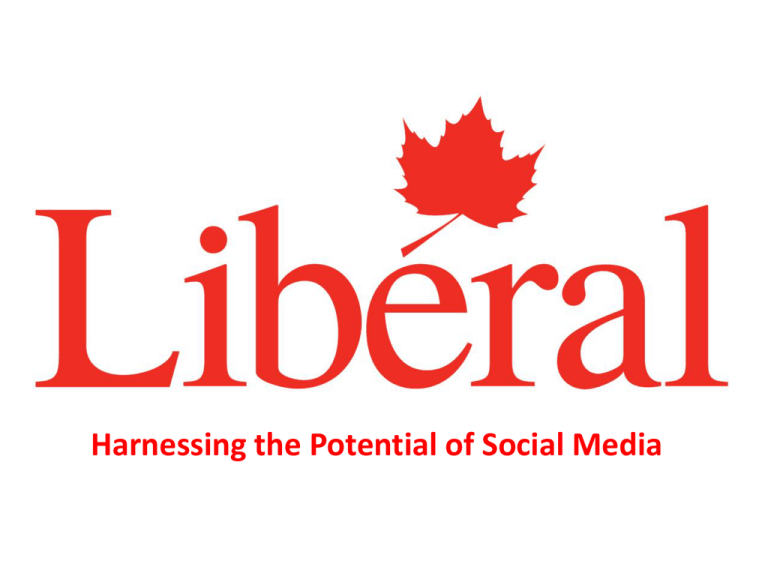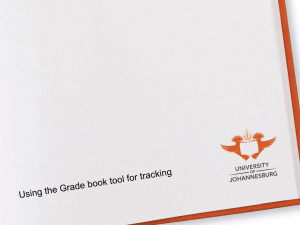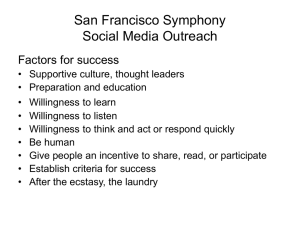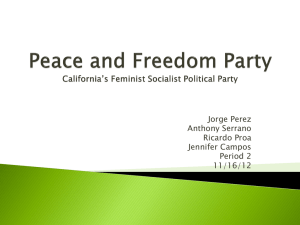Introduction - Liberal Party of Canada
advertisement

Communicating Effectively in Your Riding Harnessing the Potential of Social Media Introduction › Why We’re Liberals › Our Stories › Lessons Learned › Social Media for Your FLA 2 Introduction › Why I’m a Liberal › My Story small, individual efforts are amplified when carried › Lessons Learned I became a member of the Liberal Party because my out in concert with other similarly minded citizens. 3 Introduction › Where was I a year ago? › › › › › Using Twitter sparingly Using Facebook socially Learning Wordpress Vaguely familiar with Photoshop Politically interested, not involved 4 Introduction › Why I’m a Liberal › My Story › Lessons Learned 5 Introduction › Highlights from 2011/12: › 4th on Twitter out of 1524 candidates federally in 2011 › @ABoldNewRed featured in MediaMiser social media study, written about by Susan Delacourt › 600 tweet weekend at Biennial 6 Introduction › Where am I today? › › › › › Using Twitter professionally for OLP Admin of countless Facebook pages Use Wordpress + other platforms daily Designing with Photoshop at work Living a 24/7 political lifestyle 7 Introduction › Social Media accounts I manage: › › › › › › Ontario Liberal Party Liberal Party of Canada (Ontario) LPC President Mike Crawley Liberals in Action LPC Social Media help group Federal/Provincial Associations 8 Introduction › What I’ve learned: › ANYONE can do social media › › › › You don’t need to be tech-savvy You don’t need to be young You don’t need a comms background You don’t need prior knowledge … you just have to be willing to learn 9 Introduction Why should you use social media and what do you need to know? 10 Introduction ›Why should you use social media? › › › › Irreversible cultural change 83% of Canadians on Facebook Engage Ontarians on their terms Be part of the conversation about our Party 11 Introduction 5 rules of social media: 1. Don’t over-promote 2. Encourage engagement 3. Stay interesting and significant 4. Watch for meaningful feedback 5. Be relentless about improvement 12 Introduction We have one aim in messaging: We want our target audience to see our values as their values and identify as Liberals. 13 Introduction 2 questions to ask yourself: 1. Will what I’m communicating encourage local members to get involved, stay involved, or become more involved with the Liberal Party? 2. Will what I’m communicating encourage members of my community to support the Liberal Party and vote for our candidate in the next election? 14 Introduction › Start with a plan. Before you begin, figure out: › › › › › › What is your message? Who is your target? What tools will you use? Who will do what? What do you want to achieve and by when? Are you prepared? 15 Introduction Your Message What are the issues that resonate locally with targeted audiences? 16 Introduction Who is your target audience? › LPC(O) Members › Donors › General Public 17 Introduction What tools will you use? › Website › Twitter › Facebook › Letters to the editor › News releases 18 Introduction Why that tool? › Different targets, different media › Choose what works best with your target audience and your message 19 Introduction Who will do what? › Who is writing? › Who will post on social media? › Who will be spokesperson? 20 Introduction Create a FLA Comms Team › Create opportunity for involvement › Split up the workload › Use the full talent of your members › Get a second set of eyes on work 21 Introduction Set Realistic Goals and Timelines › Set goals that allow you to see results › Choose deadlines you can reasonably meet 22 Introduction Are you prepared? › Do the groundwork › Clip and save articles › File Party emails › Develop lists of key people 23 Introduction Know your opponents: › › › › › What they’re saying and to who Track their positions on the issues Save clippings about their comments Set up a Google alert for them Challenge their message 24 Introduction Include a call to action: ›Volunteer ›Join ›Donate 25 Introduction Leveraging relationships: › › › › Make a Facebook event Sharing photos Organize a TweetUp Get creative 26 Conclusion Thank You











